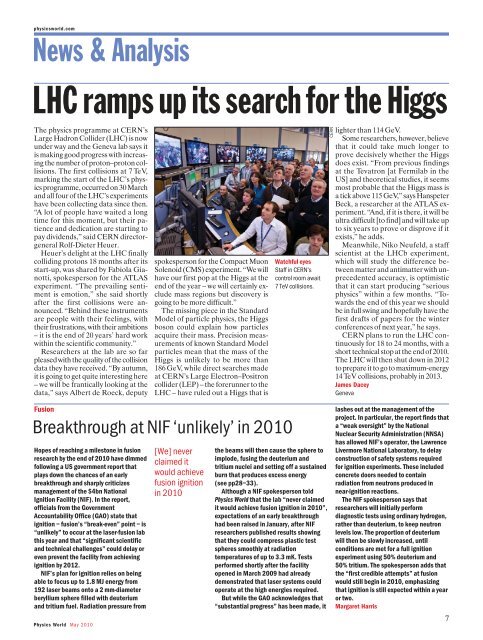special issue
special issue
special issue
Create successful ePaper yourself
Turn your PDF publications into a flip-book with our unique Google optimized e-Paper software.
physicsworld.comNews & AnalysisLHC ramps up its search for the HiggsThe physics programme at CERN’sLarge Hadron Collider (LHC) is nowunder way and the Geneva lab says itis making good progress with increasingthe number of proton–proton col -lisions. The first collisions at 7 TeV,marking the start of the LHC’s phys -ics programme, occurred on 30 Marchand all four of the LHC’s experimentshave been collecting data since then.“A lot of people have waited a longtime for this moment, but their pa -tience and dedication are starting topay dividends,” said CERN directorgeneralRolf-Dieter Heuer.Heuer’s delight at the LHC finallycolliding protons 18 months after itsstart-up, was shared by Fabiola Gia -notti, spokesperson for the ATLASex periment. “The prevailing sentimentis emotion,” she said shortlyafter the first collisions were an -nounced. “Behind these instrumentsare people with their feelings, withtheir frustrations, with their ambitions– it is the end of 20 years’ hard workwithin the scientific community.”Researchers at the lab are so farpleased with the quality of the collisiondata they have received. “By autumn,it is going to get quite interesting here– we will be frantically looking at thedata,” says Albert de Roeck, deputyHopes of reaching a milestone in fusionresearch by the end of 2010 have dimmedfollowing a US government report thatplays down the chances of an earlybreakthrough and sharply criticizesmanagement of the $4bn NationalIgnition Facility (NIF). In the report,officials from the GovernmentAccountability Office (GAO) state thatignition – fusion’s “break-even” point – is“unlikely” to occur at the laser-fusion labthis year and that “significant scientificand technical challenges” could delay oreven prevent the facility from achievingignition by 2012.NIF’s plan for ignition relies on beingable to focus up to 1.8 MJ energy from192 laser beams onto a 2 mm-diameterberyllium sphere filled with deuteriumand tritium fuel. Radiation pressure fromspokesperson for the Compact MuonSolenoid (CMS) ex periment. “We willhave our first pop at the Higgs at theend of the year – we will certainly ex -clude mass regions but discovery isgoing to be more difficult.”The missing piece in the StandardModel of particle physics, the Higgsboson could explain how particlesacquire their mass. Precision measurementsof known Standard Modelparticles mean that the mass of theHiggs is unlikely to be more than186 GeV, while direct searches madeat CERN’s Large Electron–Positroncollider (LEP) – the forerunner to theLHC – have ruled out a Higgs that isFusionBreakthrough at NIF ‘unlikely’ in 2010Physics World May 2010[We] neverclaimed itwould achievefusion ignitionin 2010Watchful eyesStaff in CERN’scontrol room await7 TeV collisions.the beams will then cause the sphere toimplode, fusing the deuterium andtritium nuclei and setting off a sustainedburn that produces excess energy(see pp28– 33).Although a NIF spokesperson toldPhysics World that the lab “never claimedit would achieve fusion ignition in 2010”,expectations of an early breakthroughhad been raised in January, after NIFresearchers published results showingthat they could compress plastic testspheres smoothly at radiationtemperatures of up to 3.3 mK. Testsperformed shortly after the facilityopened in March 2009 had alreadydemonstrated that laser systems couldoperate at the high energies required.But while the GAO acknowledges that“substantial progress” has been made, itCERNlighter than 114 GeV.Some researchers, however, be lievethat it could take much longer toprove decisively whether the Higgsdoes exist. “From previous findingsat the Tevatron [at Fermilab in theUS] and theoretical studies, it seemsmost prob able that the Higgs mass isa tick above 115 GeV,” says HanspeterBeck, a researcher at the ATLAS ex -peri ment. “And, if it is there, it will beultra difficult [to find] and will take upto six years to prove or disprove if itex ists,” he adds.Meanwhile, Niko Neufeld, a staffscientist at the LHCb experiment,which will study the difference be -tween matter and antimatter with un -precedented accuracy, is optimisticthat it can start producing “seriousphysics” within a few months. “To -wards the end of this year we shouldbe in full swing and hopefully have thefirst drafts of pa pers for the winterconferences of next year,” he says.CERN plans to run the LHC continuouslyfor 18 to 24 months, with ashort technical stop at the end of 2010.The LHC will then shut down in 2012to prepare it to go to maximum-energy14 TeV collisions, probably in 2013.James DaceyGenevalashes out at the management of theproject. In particular, the report finds thata “weak oversight” by the NationalNuclear Security Administration (NNSA)has allowed NIF’s operator, the LawrenceLivermore National Laboratory, to delayconstruction of safety systems requiredfor ignition experiments. These includedconcrete doors needed to containradiation from neutrons produced innear-ignition reactions.The NIF spokesperson says thatresearchers will initially performdiagnostic tests using ordinary hydrogen,rather than deuterium, to keep neutronlevels low. The proportion of deuteriumwill then be slowly increased, untilconditions are met for a full ignitionexperiment using 50% deuterium and50% tritium. The spokesperson adds thatthe “first credible attempts” at fusionwould still begin in 2010, emphasizingthat ignition is still expected within a yearor two.Margaret Harris7



